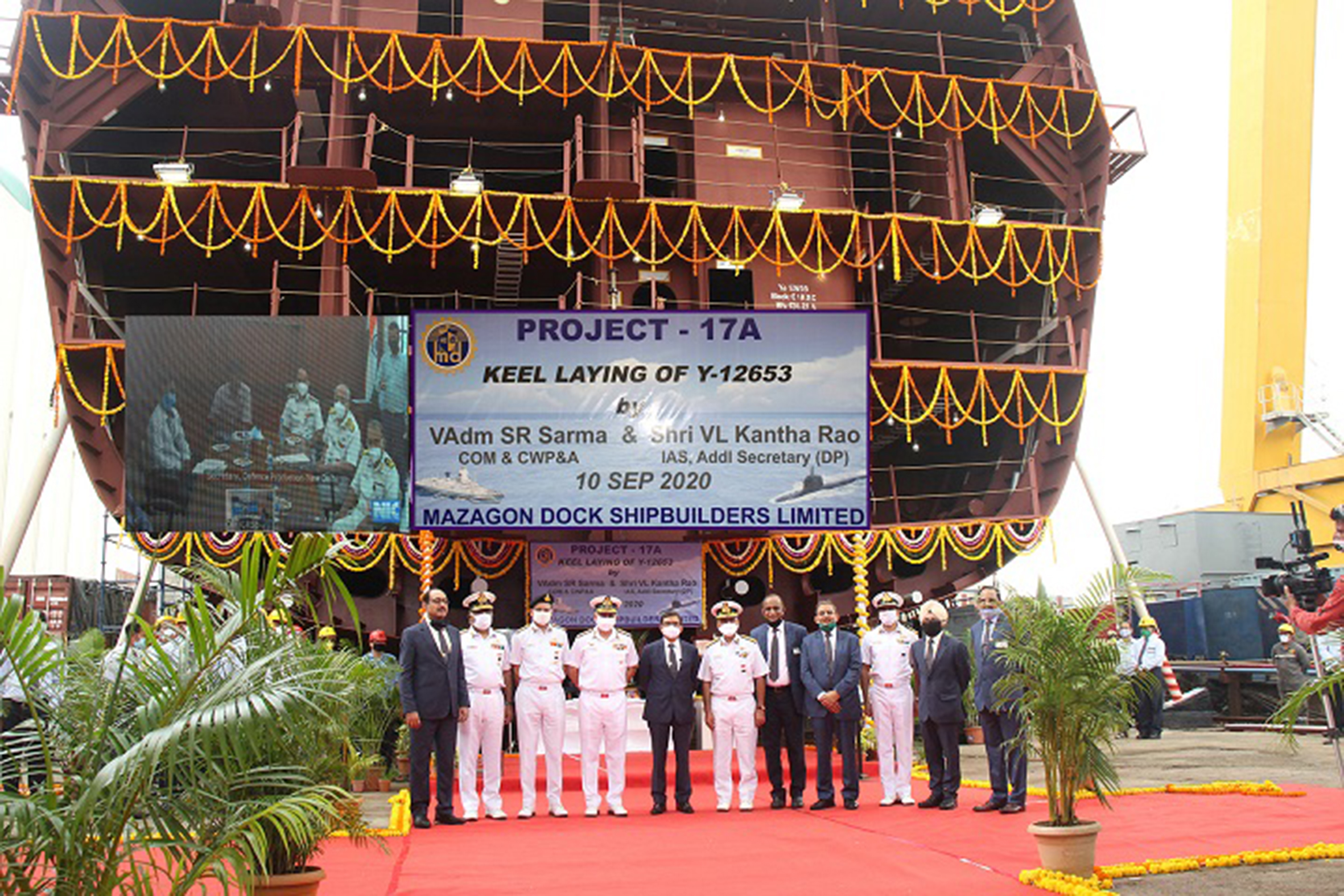news details |
|
|
| Keel laid for the third stealth frigate of Indian Navy’s Project 17A | | | 
Col Anil Bhat, VSM (Retd)
Vice Admiral S R Sarma – Controller of Warship Production & Acquisition (CWP&A) of the Indian Navy and Mr. V L Kantha Rao Additional Secretary (Defence Production) laid the keel of the third ship (Yard- 12653) of the prestigious P17A class stealth frigates on 10 Sep 2020. The keel laying ceremony was conducted through an e-platform in the presence of Vice Admiral R B Pandit, Chief of Staff, HQ,Western Naval Command and Vice Admiral Narayan Prasad (IN Retd.) – CMD, Mazgaon Dockyard Limited (MDL).
A stealth ship is a ship is one which is built/constructed with stealth technology construction techniques to try to ensure that it is harder to detect by one or more of radar, visual, sonar, and infrared methods. To explain further, a stealth vessel is one which will give wrong inputs to the observer or not give the impression to the observer that it is a stealth ship.
Seven frigates under P17A series will be constructed of which four are being constructed in MDL and three in GRSE with MDL as the lead yard. The P17A class frigates are being built using indigenously developed steel and fitted with weapons and sensors along with Integrated Platform Management System. These ships are having stealth features. Construction of P17A ships differ in the very concept of warship building by way of adoption of the modern technology ‘Integrated Construction (IC)’ where the blocks are pre-outfitted before joining to reduce the build period of warships. When commissioned the platforms will enhance the combat capability of the Indian Naval fleet.
The function was attended by officials and executives from MDL and Indian Navy including the Warship Overseeing Team through an e-ceremony.
According to a Defense News report of October 30, 2018 citing an Indian Defence Ministry official, India signed a $950 million contract with Russia for two upgraded Krivak III-class stealth frigates. A government-to-government contract was signed between India and United Shipbuilding Corporation of Russia last week for the supply of two stealth frigates after two years of negotiations. The deal came after Russian President Vladimir Putin visited India on October 5, 2018 and the ruling National Democratic Alliance government made a $5.43 billion deal to buy five Russian S-400 Triumf missile systems despite objections from its ally the United States.
The procurement of the frigates would involve a rupee-rouble transaction instead of using U.S. dollars to avoid American sanctions on Russian defense companies under CAATSA, or the Countering America’s Adversaries Through Sanctions Act. The frigates are built by Yantar Shipyard of Russia and will be powered by Ukrainian gas turbine engines. They will be equipped with Indian-built radar, sonar, communication suites and anti-ship BrahMos missile systems, an Indian Navy official said. The ships are expected to be delivered by the end of 2022.
India and Russia signed an agreement in October 2016 for the purchase and construction of four additional upgraded Kravak III-class stealth frigates, under which two frigates will be directly supplied by Russia and two others built at state-owned Goa Shipyard Limited in India though a technology transfer.
A separate contract was to be signed in 2019 for the construction of two similar stealth frigates in India. The 4,000-ton Krivak III vessels will also accommodate two multirole helicopters and will be used for anti-submarine and airborne early warning missions.
India has already built seven basic versions of Krivak-class stealth frigates under the Navy’s Project 17A scheme at state-owned shipyards Mazagon Dock Limited, and Garden Reach Shipbuilders and Engineers.
81235
India has already built seven basic versions of Krivak-class stealth frigates under Indian Navy’s Project 17A scheme at state-owned shipyards Mazagon Dock Limited, and Garden Reach ShipSSbuilders and Engineers. The Indian Navy currently has a fleet strength of 140 warships, with plans to increase that number to 198 by 2027.
India’s ship-building capability and capacity have both improved substantially and at least in MDL and GRSE there are shios being built for India’s navy and coast guard, which is heartening as compared to a decade ago. While in the Indian Ocean region the deployment of our military vessels is quite optimal, should the need arise to deploy in the South China Sea region, the Indian Navy should be in a position to do so. There has been a steady spell of strategic maritime cooperation with countries in that region like Japan and Vietnam. India has also been cooperating strategically with the US and some other countries. In fact, Indian Navy is in great demand from any counties for cooperation or joint exercises. |
|
|
|
|
|
|
|
|
|
|
|
|
| |
| |
|
|
|
|
 |
|
|
